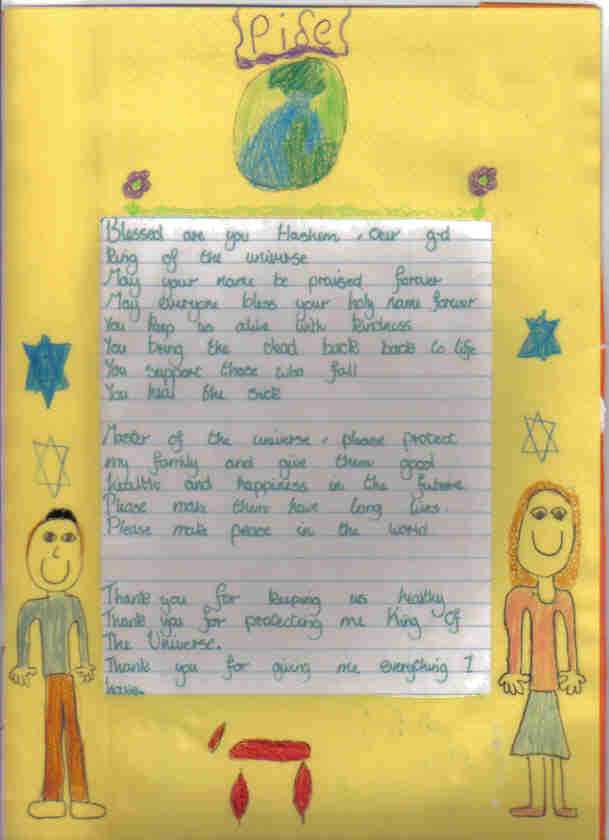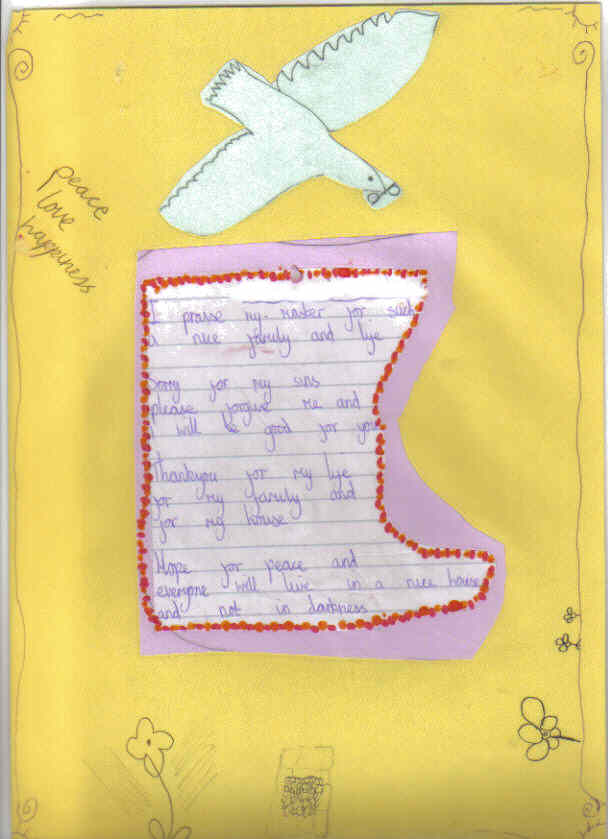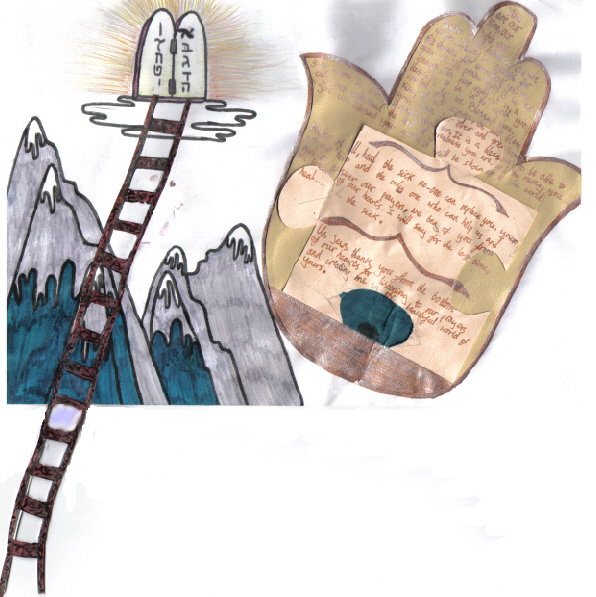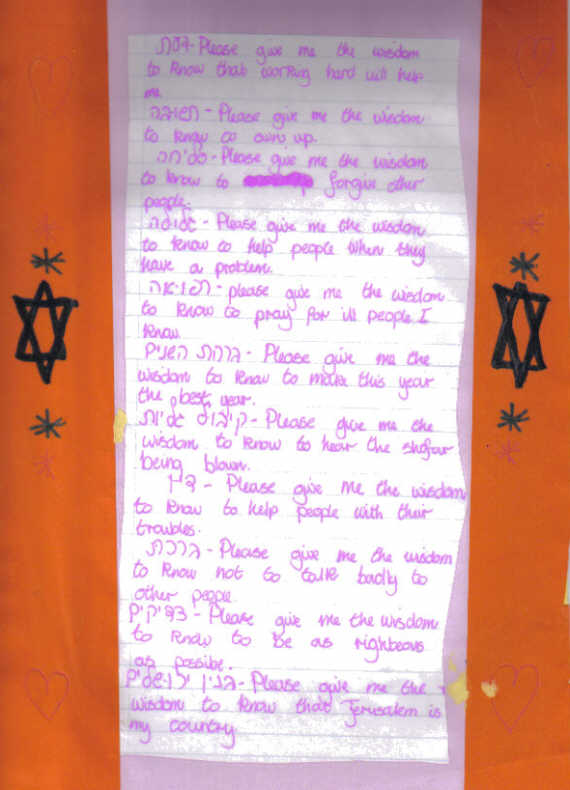Shemoneh Esrei Project
(Kerem School 2003, 2004)
Overview
The two main parts of the project were as follows:
1. We wrote tefillot of our own, composed in three main sections according to the structure of the Shemoneh Esrei (Amidah): Shevach (praise) Bakashah(requesting) and Hoda’ah (thanking).
2. We then wrote “Kavannah Aids“ – one short thought relating to each of the thirteen individual berachot in the “Bakashah” section.
Now learn what we did in more detail.
The Project in Detail
Part 1: Writing My Own Tefillah
A) The Brainstorm – we began with a brainstorming session. We thought of anything we might want to say to Hashem, or anything that might come under the general heading, “Tefillah.”
Brainstorm 1:
This is our first brainstorm on tefillah, which we built as a class. It involved a lot of discussion and really got us thinking deeply about all kinds of ideas.
BRAINSTORM 1

Brainstorm 2:
Here is the kind of brainstorm you might work towards. Use this one for ideas and to stimulate thinking and discussion of your own. We came up with something like this just before writing our own tefillot. It was a good reminder of, but was more focused than the more general discussion which had formed the first brainstorm.
BRAINSTORM 2
Here is our second brainstorm, and below it is an animation which shows how it developed.

Now look how the above brainstorm came together. It runs through the animation cycle twice, so click ‘Reload’ / ‘Refresh’ if you missed it.

Examples of Children’s Brainstorms
2004 / 5764
Rivka’s First Brainstorm

Rivka’s Second Brainstorm

Esther’s Brainstorm

Rachel and Shoshana’s Brainstorm

B) A Structure for My Tefillah – In order to decide on a structure for our tefillot we first analysed the structure that Chazal (the Rabbis, of blessed memory) used for the Shemoneh Esrei. We learnt that the Shemoneh Esrei consists of three main sections. These are shown in the following table:

The first section, “Shevach – Praise,” consists of the first three Berachot,
the second section, “Bakashah – Requesting,” comprises the middle thirteen Berachot and the last three Berachot, “Hoda’ah – Thanking,” make up the third section.
(Count the total: 3+13+3 = 19 Berachot – so why the name “Shemoneh Esrei?” [which means 18] This is one for research and class discussion!)
We looked at the different Berachot in the Shemoneh Esrei in order to understand these categories and see examples of Berachot in each category.
C) My Own Tefillah – We started to think about how we could use the same categories, Shevach, Bakashah, Hoda’ah, in composing our own Tefilot. Ideas and guidance were given to help get the pupils started. Some of the background to the pupils’ compositions appears in the following table:


D) Illustrating the Tefillah – once the Tefillot were written, the pupils designed their own illustrations around the page. We looked at the beautiful Artscroll Children’s Siddur for inspiration, but, in general, the pupils’ final designs were very much their own creative work.
E) Medium / Format – our Tefillot were written, in a kind of blank verse poem format. Equally, other formats and media could be employed: song, acting/role play, Powerpoint presentation, video (e.g. film of sky, sea and countryside for praise, objects / athletes (representing good health) / food / money / smiling faces (representing happiness) for please / thank You), photo montage (similar ideas to video).
Examples of Work
2003 / 5763
Aliza’s Tefillah

Amalia’s Tefillah

Ariella’s Tefillah

Avigail’s Tefillah

Esther’s Tefillah

Nechama’s Tefillah

Sara’s Tefillah

Shifra’s Tefillah

Uri and Avraham’s Tefillah

Zahava’s Tefillah

2004 / 5764
Esther’s Tefillah


Emma’ Tefillah

Nachum’s Tefillah

Naomi’s Tefillah

Nir’s Tefillah

Rachel’s Tefillah

Rivka’s Tefillah


Shifra’s Tefillah

Shlomo’s Tefillah

Shmuel C.’s Tefillah

Shoshana

Tzila’s Tefillah

Yisca’s Tefillah
1) Here is Yisca’s Tefillah while she was still working on the intricate design at the bottom:

2) Here is Yisca’s Tefillah once she had finished the intricate design at the bottom (well done!):

***
Part 2: Kavannah Aids
The focus on Tefillah in these exercises (Part 1, above and Part 2, here) is Tefillah as a spiritual-emotional act rather than Tefillah as a textual study. Therefore, little emphasis, as yet, is being placed on the textual detail. Rather, we are using the ideas, thoughts, spiritual and emotional prompts as stimuli for sensitizing the pupils to the tefillot on a personal level.
I see this as leading to what we could term “emotional fluency” – achieving a general ‘feel’ for the meanings and meaningfulness of the prayers – as a preparation for “emotional decoding” – a closer appreciation of the meanings, not just instinctive understanding but also those meanings specifically constructed and inserted by Chazal, our Rabbis, of blessed memory – just as “textual fluency” – achieving an ability to read and translate significant quantities of text fluently but with limited understanding – is a helpful prerequisite for “textual decoding” – analysing and breaking down the component parts in perakim (chapters), pesukim (verses), phrases and individual words.
In both cases, the objective is that fluency leads to motivation, personal interest and confidence and a preparedness to make a more detailed analysis.
Here are the instructions which were given to the pupils to get them started on Part 2 of our project. Again, we used the beautiful Artscroll Children’s Siddur for inspiration and to help us with our work.
Part 2: Kavannah Aids
Instructions for Pupils
|
1 |
2 |
|
3
|
4 |
|
5 Find out what do the Rabbis say about wisdom. Now, decide on a single thought that you can have in mind the moment after you recite the Berachah on Daat. For example: “Please, Hashem, help me to have the wisdom to make friends with people who will be a good influence on me,” Write the heading,
and then write the single thought that you have composed. For the next berachah, which is
Think up similar single thoughts for each of the Bakashot in the Amidah, from number 4, Daat / Binah, to number 16, Kabbalat Tefillah. |
|
When you have finished, this piece of work will be put back to back with your personal Tefillah and they will be laminated together to make a really special, personal Tefillah card to help you daven with more feeling, more thoughtfully.
Examples of Work, 2
2003 / 5763
Aliza’s Tefillah, Part 2


Amalia’s Tefillah, Part 2

Ariella’s Tefillah, Part 2

Avigail’s Tefillah, Part 2

Esther’s Tefillah, Part 2


Zahava’s Tefillah, Part 2

2004 / 5764
Yisca, Naomi and Talia’s Tefillah, Part 2

Rivka B.’s Tefillah, Part 2


Rivka M.’s Tefillah, Part 2




